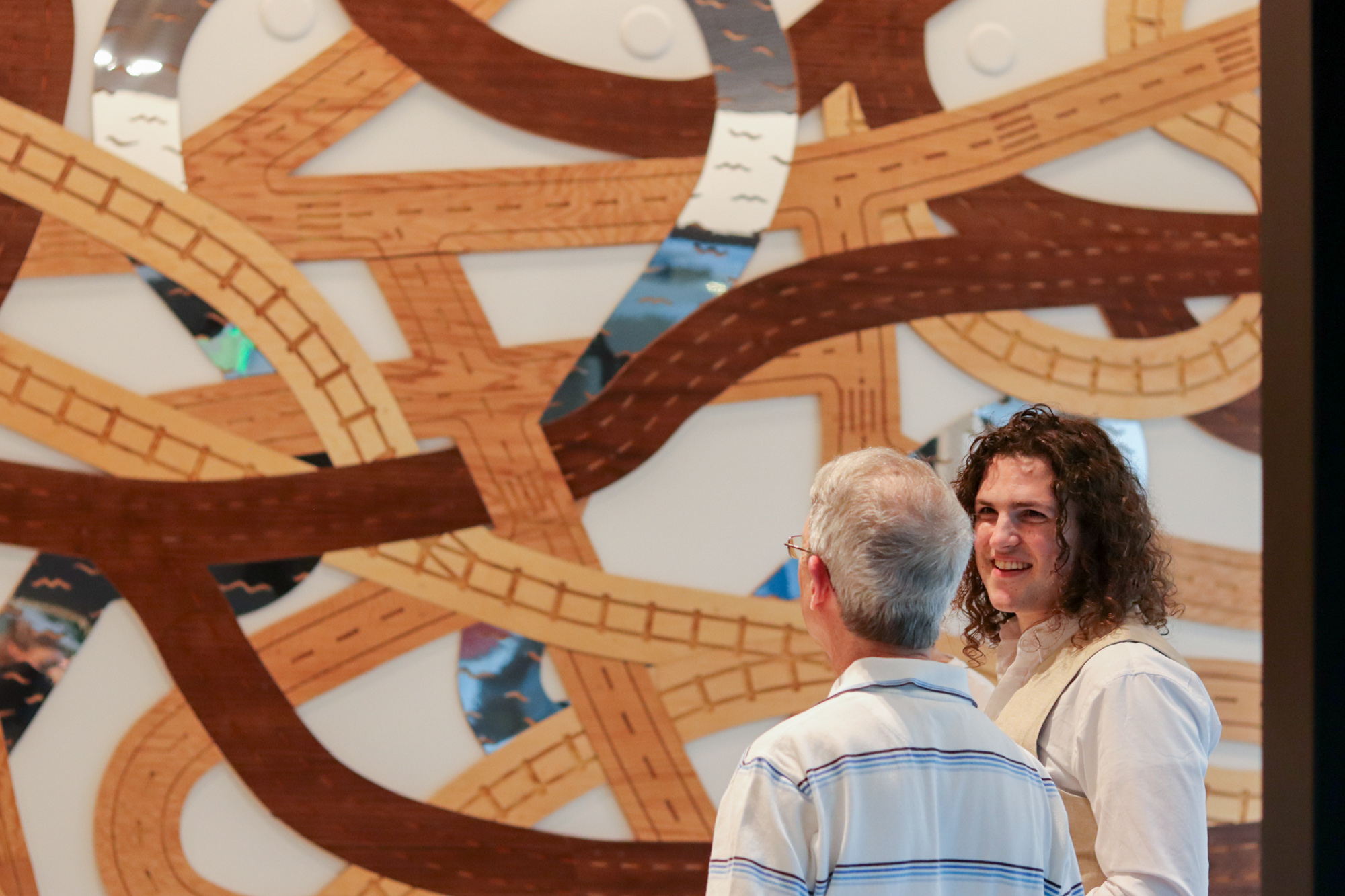A Boston University College of Fine Arts alumnus debuted a Boston transit-themed art installation called “Woven City” in Allston Thursday night.
Alexander Golob, who graduated from CFA in 2016, was born in Cambridge and has created public art in the greater Boston area for over a decade. He said “Woven City” took inspiration from Boston’s transportation infrastructure.

The installation was commissioned by The Hamilton Company, for its apartment building located at 55 Brighton Avenue in Packard’s Corner. The Hamilton Company CEO Jameson Brown said the architectural concept of the building was inspired by the “transportation history of the neighborhood,” so the New England real estate firm was looking for a similar concept for the artwork.
“We sort of let [Golob] take it where he wanted, and he drew more on all the transportation inspiration, but across all the different modes that have gone through this neighborhood,” Brown said.
The largest element of the installation is the woven city itself, a 31 by 31, 14-foot high installation of maple, oak and walnut wood, cut to resemble an abstraction of Boston roads, highways and MBTA tracks. A reflective aluminum piece represents the Charles River.
Golob said the materials he used symbolize a human connection to nature. Organic materials like wood represented the man-made modes of transportation, while inorganic materials like aluminum represented the Charles River.
“These modes of movement are part of the thing that both … people in [the] Greater Boston area and students create, but then also are shaped by them,” Golob said. “These are spaces that we forge and that then forge us.”
There are four folk-Americana-style paintings at each corner of the installation, each depicting a different mode of transit from Boston and Allston’s history — the Allston speedway coach and buggy, the old A-line subway, the 97 bus and the Packard’s Corner automobile.
Sasha Kedzie, Golob’s partner and collaborator, said these paintings “created anchors in the timeline” as technology evolves.
When conceptualizing the piece, Kedzie said she and Golob loved “the tangle of a city” idea.
“A healthy society is a tapestry, but it is also a living organism, and it is also all these systems,” Kedzie said. “Everything is so entwined.”
The piece is also meant to be “playful,” taking inspiration from children’s rugs depicting roads and train tracks, Golob said, further symbolizing how “relationships are woven together.”
“I wanted to create something that was, in part, a love letter to the city and to the neighborhood that I’ve lived in and that I’ve called home,” Golob said. “While also trying to elicit a sense of wonder from people who are not from this neighborhood.”
“In hopes that it eventually does turn into a love letter for them as well,” Golob continued.
Golob has done several pieces of public art for BU’s campus. His first public piece was a mural titled “Kaleidoscope” on the side of the CFA building beside the building’s parking lot.
Natalie McKnight, dean and professor of humanities at the BU College of General Studies, commissioned several pieces of work from Golob over the years. She first heard of Golob from his “Kaleidoscope” mural, and he approached her as an undergraduate student about doing some public art for CGS.
“I instantly decided I would like him to help me transform the CGS back stairwell, a similarly bleak space [to the CFA parking lot], which is now lively, colorful and compelling,” McKnight wrote in an email. “It’s a pleasure just walking up and down those stairs.”
McKnight wrote that public art can improve the aesthetic appeal of “visually-challenged areas” while reminding viewers of the people those “soulless structures” were built for.
“Public art is as essential to workable, livable cities as good public transportation,” McKnight wrote. “We should be investing in both.”
Kedzie said she and Golob believe art is meant to be shared to do its job. She said Golob works to emphasize equity in the art world by bringing art “back into the neighborhoods” and reflecting the stories of the people who live there, and that this is evident in “Woven City.”
The 55 Brighton Avenue apartment building does not rent out to undergraduate students, Brown said, but the lobby is open to the public to view the exhibit. Brown said The Hamilton Company hopes those who see it view it as an improvement to the neighborhood.
Golob said “it’s a privilege” to do public art for his alma mater and hometown, since “art has a unique capacity to transform our lives on a really fundamental basis.”
“Unlike a work of art that’s in a gallery, this is a way for a community to assert values,” Golob said.
























































































































Sandeep • Jul 12, 2024 at 4:19 am
Congratulations to the artist for debuting this impressive piece in Allston! It’s definitely a must-visit for anyone interested in how art intersects with daily life.